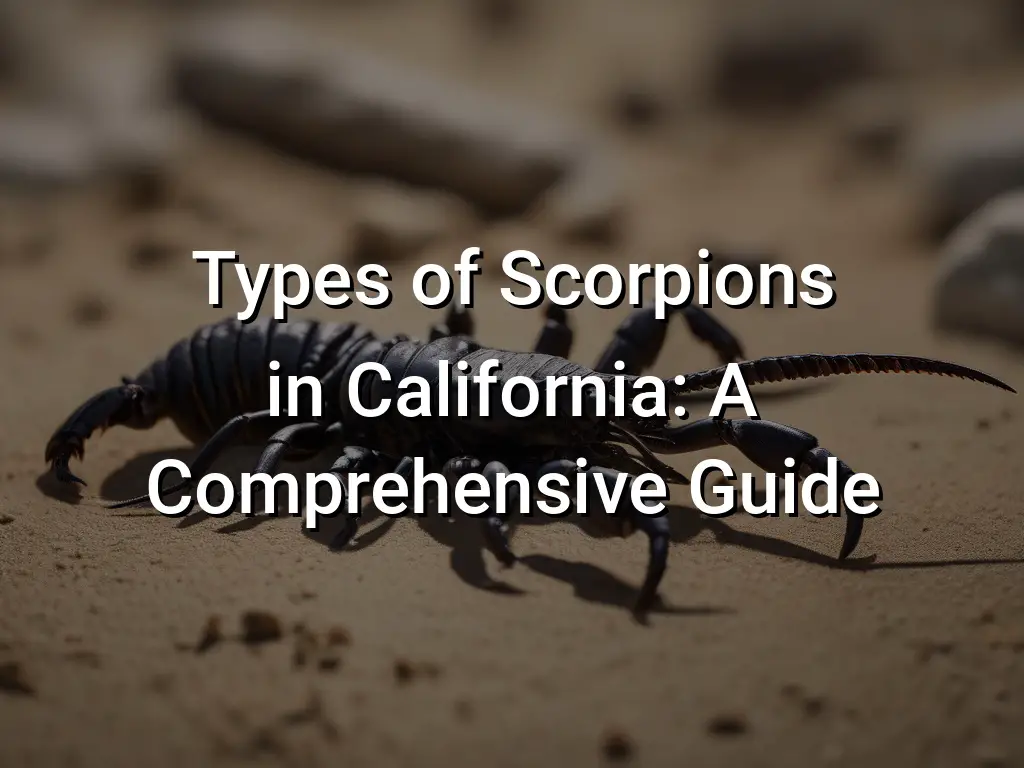Types of Scorpions in California: A Comprehensive Guide

Are you curious about the scorpions that call California home? Look no further! California is home to a fascinating array of scorpion species, each offering its own unique characteristics and behaviors. From the venomous Bark Scorpion to the impressive Giant Hairy Scorpion, join us on a comprehensive journey through the different types of scorpions found in California.
Whether you’re an arachnid enthusiast or simply interested in learning more about the captivating wildlife of California, this guide will provide you with valuable insights into the diverse scorpion species that inhabit the state. Get ready to explore the intriguing world of scorpions in California!
Quick Links
Bark Scorpion
The Bark Scorpion is one of the most common types of scorpions found in California. It is also known as the Arizona Bark Scorpion, as it is found in both states. This scorpion is usually light brown in color and has a slender body, ranging from 2.5 to 3.5 inches in length.
The Bark Scorpion is known for its venomous sting, which can be painful and occasionally dangerous, especially for children and those with allergies. Its sting can cause symptoms such as numbness, tingling, muscle twitching, and difficulty breathing. If stung, it is important to seek medical attention.
This scorpion prefers dry and arid habitats, such as deserts and rocky areas. It is commonly found hiding in crevices, under rocks, or in piles of debris. Bark Scorpions are nocturnal and hunt for insects at night.
To prevent encounters with Bark Scorpions, it is important to keep your home and surroundings free of clutter and debris. Seal any cracks or crevices in your home and make sure screens on doors and windows are intact. Shake out shoes and clothing before putting them on, especially if they have been left outside.
Although the Bark Scorpion can be a nuisance and potentially dangerous, it plays an important role in the ecosystem by controlling insect populations. If you come across a Bark Scorpion, it is best to admire it from a distance and let it go about its business.
Giant Hairy Scorpion
The Giant Hairy Scorpion, also known as the Hadrurus arizonensis, is one of the largest scorpions found in California. It can grow up to 6 inches in length and is easily identifiable by its large size and hairy appearance. This scorpion is native to the deserts of California and can be found in rocky areas, sand dunes, and desert habitats.
The Giant Hairy Scorpion has a tan or yellowish-brown color with dark brown or black markings on its body. It has large pincers, long and slender pedipalps, and a long, segmented tail that ends with a stinger. Despite its intimidating appearance, the Giant Hairy Scorpion is not considered highly venomous to humans, although its sting can cause pain and discomfort.
This scorpion is primarily nocturnal and spends its days hiding in burrows or under rocks to avoid the heat of the desert sun. At night, it emerges to hunt for prey, which mainly consists of insects, spiders, and other small invertebrates. The Giant Hairy Scorpion is a solitary creature and prefers to live alone.
When threatened, the Giant Hairy Scorpion will raise its tail and display its stinger as a warning. If provoked further, it may sting in self-defense. It is important to exercise caution and avoid handling or approaching this scorpion, as its sting can cause pain, swelling, and other symptoms in humans.
Despite their fearsome appearance and reputation, scorpions play an important role in the ecosystem as predators, helping to control populations of smaller animals. They are a fascinating part of California’s desert habitats and are best admired from a safe distance.
Stripetail Scorpion
The Stripetail Scorpion, also known as the Vaejovis spinigerus, is a species of scorpion that is commonly found in California. It is named after the distinctive striping pattern on its tail.
This scorpion is relatively small, typically measuring around 3 inches in length. It has a reddish-brown coloration with darker stripes on its tail. The Stripetail Scorpion has eight legs and a pair of pincers that it uses for capturing prey.
Stripetail Scorpions are nocturnal creatures and are most active at night. They are typically found in dry areas with rocky or sandy soil, such as deserts, grasslands, and chaparral habitats. These scorpions are excellent burrowers and will create underground burrows where they can hide during the day and hunt for prey at night.
Like all scorpions, the Stripetail Scorpion is venomous. However, its venom is not considered to be highly dangerous to humans. Its sting is typically described as being similar to a bee sting, causing localized pain, swelling, and redness. Most people do not have severe reactions to the venom, but individuals who are allergic or particularly sensitive to insect stings may experience more significant symptoms.
These scorpions primarily feed on small insects and spiders. Their diet may include ants, beetles, crickets, and other small arthropods. Stripetail Scorpions use their pincers to capture and immobilize their prey before injecting venom to subdue it.
Overall, the Stripetail Scorpion is an interesting and relatively common species of scorpion in California. While it is venomous, its sting is usually not cause for significant concern. It is a fascinating creature to observe in its natural habitat, but caution should be taken to avoid unnecessary contact or disturbances.
California Forest Scorpion
The California Forest Scorpion, also known as the Uroctonus mordax, is a common species of scorpion found in California. It is a medium-sized scorpion, typically growing up to 2.5 to 3 inches in length.
One of the distinguishing features of the California Forest Scorpion is its dark brown or black coloration, which helps it blend in with its forest habitat. It has a slender body with long, thin pincers and a segmented tail with a stinger at the end.
Despite its intimidating appearance, the California Forest Scorpion is not considered highly dangerous to humans. Its sting is generally mild, similar to a bee or wasp sting, and usually only causes localized pain, swelling, and redness. However, individuals who are allergic or have a sensitivity to scorpion venom may experience more severe symptoms and should seek medical attention if stung.
The California Forest Scorpion is primarily nocturnal and hunts at night. It is a solitary creature, preferring to hide in crevices and under rocks during the day. At night, it emerges to search for prey, which mainly consists of small insects and spiders.
These scorpions are commonly found in forested areas, including oak woodlands, chaparral, and coastal forests. They can also be found in residential areas near wooded areas or gardens with suitable hiding places.
If you encounter a California Forest Scorpion, it is best to observe it from a distance and avoid handling it. Like all scorpions, it is equipped with venomous stingers and can use them in self-defense if threatened. Keeping your living spaces clean, sealing crevices, and removing clutter can help minimize the chance of scorpions making their way indoors.
California Common Scorpion
The California Common Scorpion, also known as the California Scorpion or California Forest Scorpion, is one of the most common scorpion species found in California. It is native to the state and can be found in various habitats, including forests, woodlands, and even urban areas.
Appearance-wise, the California Common Scorpion is typically light brown or tan in color. It has a long, slender body and is usually around 2-3 inches in length. Like other scorpions, it has a pair of pincers (pedipalps) and a long, segmented tail with a venomous stinger at the end.
Despite its venomous nature, the California Common Scorpion is generally not considered dangerous to humans. Its venom is mild and its sting is usually no more painful than a bee or wasp sting. However, individuals who are allergic or have a severe reaction to scorpion venom should seek medical attention if stung.
The California Common Scorpion is primarily nocturnal, meaning it is most active during the night. During the day, it typically hides in burrows or other dark, sheltered areas to avoid predators and extreme temperatures. It feeds on a variety of small insects and spiders.
If you encounter a California Common Scorpion, it is important to exercise caution and avoid provoking or handling it. Scorpions are known for their ability to deliver painful stings if threatened or disturbed. It is best to leave them alone and allow them to continue their natural behavior.
In conclusion, the California Common Scorpion is a common and relatively harmless scorpion species found in California. While it may appear intimidating, it poses little threat to humans and plays an important role in controlling insect populations in its native habitat.
Western Desert Scorpion
The Western Desert Scorpion is one of the most common scorpion species found in California. It is known for its pale yellow or light brown coloration and its relatively large size, with adults reaching up to 3 inches in length.
This scorpion species is typically found in arid desert regions, such as the Mojave Desert and parts of the Sonoran Desert. They are nocturnal creatures, spending their days hiding under rocks, logs, or in burrows, and emerging at night to hunt for prey.
The diet of the Western Desert Scorpion consists mainly of insects, spiders, and other small arthropods. They use their powerful pincers to capture and subdue their prey before injecting them with venom from their stingers.
While the venom of the Western Desert Scorpion is not considered highly dangerous to humans, their sting can be painful and may cause localized swelling and discomfort. It is important to exercise caution and avoid handling or provoking these scorpions in their natural habitat.
If you encounter a Western Desert Scorpion, it is best to observe it from a safe distance and appreciate it as a fascinating creature of California’s desert ecosystems.
California Sand Scorpion
The California Sand Scorpion (Paruroctonus silvestrii) is a species of scorpion found in the sandy regions of southern California. It is known for its pale yellow color and ability to blend in with its sandy environment.
The California Sand Scorpion is relatively small, measuring around 2.5 to 3 inches in length. It has a slender body and long, thin pincers. Like other scorpions, it has eight legs and a segmented tail that ends with a sting.
Despite its intimidating appearance, the California Sand Scorpion is not considered highly venomous. Its sting is generally mild and usually only causes minor pain and swelling. However, individuals with allergies or those who are sensitive to scorpion venom may experience more severe reactions.
These scorpions are primarily nocturnal, meaning they are most active at night. They spend the day hiding in burrows or under rocks to avoid the heat of the sun. At night, they emerge to hunt for prey, which mainly consists of insects and other small invertebrates.
The California Sand Scorpion is not an aggressive species and will usually only sting if it feels threatened or provoked. It prefers to retreat and hide rather than engage in confrontation. If you happen to encounter one, it is best to observe from a safe distance and avoid disturbing or handling it.
If you live in an area where California Sand Scorpions are common, it is advisable to take precautions to prevent encounters. Seal any cracks or openings in your home to prevent them from entering, and be cautious when reaching into dark or hidden areas where they may be hiding.
Overall, the California Sand Scorpion is a fascinating and relatively harmless species of scorpion found in California’s sandy regions. It plays an important role in controlling insect populations and contributes to the ecosystem of its habitat.
Arizona Bark Scorpion
The Arizona Bark Scorpion (Centruroides sculpturatus) is one of the most common and venomous scorpions found in California. It is a small to medium-sized scorpion, measuring about 2-3 inches in length. The Arizona Bark Scorpion is light tan to light brown in color and has a slender body with long appendages.
This scorpion is nocturnal and is known for its ability to climb walls and other vertical surfaces. It is commonly found in desert regions and can often be seen in houses, especially during the warmer months when it seeks shelter from the heat.
The Arizona Bark Scorpion has a potent venom that can cause severe pain and discomfort when injected into its prey or humans. While its sting is rarely fatal to healthy adults, it can be dangerous to young children, the elderly, or individuals with compromised immune systems.
If you encounter an Arizona Bark Scorpion, it is important to exercise caution and avoid handling it. If stung, it is recommended to seek medical attention, especially if you experience severe pain, difficulty breathing, or other allergic reactions.
To prevent Arizona Bark Scorpion infestations in your home, it is essential to seal any cracks or openings that may serve as entry points. You should also remove clutter from your yard and keep vegetation well-trimmed to reduce potential hiding spots for scorpions.
Overall, while the Arizona Bark Scorpion can pose a threat to humans, with proper precautions and awareness, you can minimize the risk of encountering these venomous creatures.
Crevice Scorpion
The Crevice Scorpion, also known as Vaejovis karrooi, is a species of scorpion found in California. As the name suggests, this scorpion is commonly found in crevices and cracks in rocks and other natural formations.
The Crevice Scorpion is relatively small, measuring about 1 to 2 inches in length. It has a dark brown or black coloration, which helps it blend in with its rocky habitat. Despite its small size, the Crevice Scorpion has a venomous sting, which it uses to capture its prey.
This scorpion is nocturnal, meaning it is most active during the night. It feeds primarily on insects and other small invertebrates. During the day, the Crevice Scorpion seeks shelter in its chosen crevices, where it can remain protected from predators and extreme temperatures.
If you come across a Crevice Scorpion in California, it is important to exercise caution. While its sting is not usually dangerous to humans, it can cause pain and discomfort. It is best to avoid handling or provoking the scorpion to minimize the risk of being stung.
In conclusion, the Crevice Scorpion is a small and venomous scorpion species found in California. It is well adapted to its rocky habitat and plays an important role in the ecosystem as a predator of insects and other small invertebrates.
Eastern Black Scorpion
The Eastern Black Scorpion, also known as Vaejovis janssi, is a species of scorpion found in California. It is one of the smaller scorpion species, with adults reaching an average size of 2.5 inches in length. Despite its name, the Eastern Black Scorpion can be found in various habitats throughout California, including deserts, forests, and grasslands.
Like other scorpions, the Eastern Black Scorpion has a venomous sting that it uses to subdue its prey. However, its venom is not considered dangerous to humans, and the sting is typically described as similar to a bee sting in terms of pain and severity.
The Eastern Black Scorpion is nocturnal, meaning it is most active at night. During the day, it seeks shelter in burrows or under rocks and logs to avoid the heat of the sun. At night, it emerges to hunt for food, which typically consists of small insects and spiders.
One interesting fact about the Eastern Black Scorpion is that it is capable of producing a glowing effect under ultraviolet light. This is due to the presence of a fluorescent protein in its exoskeleton, which causes it to emit a greenish glow. This fluorescence is theorized to serve as a form of communication or defense.
If you encounter an Eastern Black Scorpion in California, it is best to observe it from a safe distance and avoid handling it. While its sting is not typically dangerous, it is always best to exercise caution and respect when interacting with any wildlife.
In conclusion, the Eastern Black Scorpion is a fascinating species of scorpion found in California. Its small size, nocturnal habits, and fluorescent properties make it an interesting creature to study and observe in its natural habitat.
Conclusion
California is home to a variety of scorpions, each with its own unique characteristics and habitat preferences. From the venomous bark scorpion to the formidable giant hairy scorpion, there is a diverse array of scorpion species found in the state.
While encountering scorpions in California is not uncommon, it’s important to remember that most species are not dangerous unless threatened. It’s always advisable to exercise caution when exploring areas known to be scorpion habitats and to take preventative measures to minimize the risk of encounters.
By familiarizing yourself with the different types of scorpions in California and understanding their behaviors and habitats, you can better protect yourself and maintain a safe and peaceful coexistence with these fascinating creatures.






